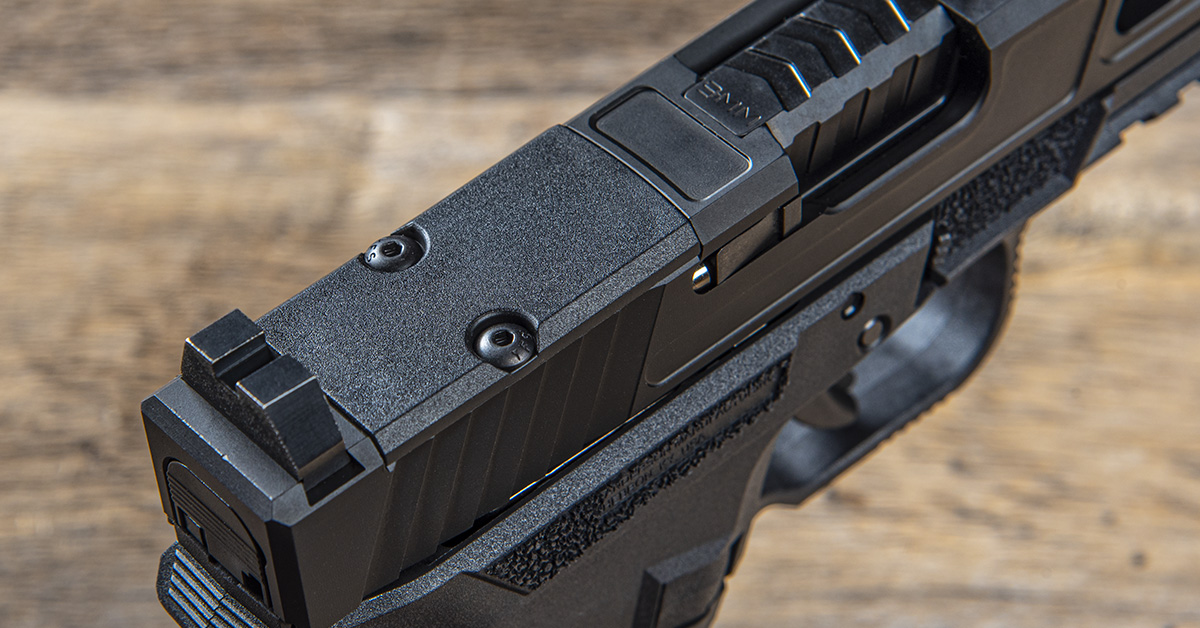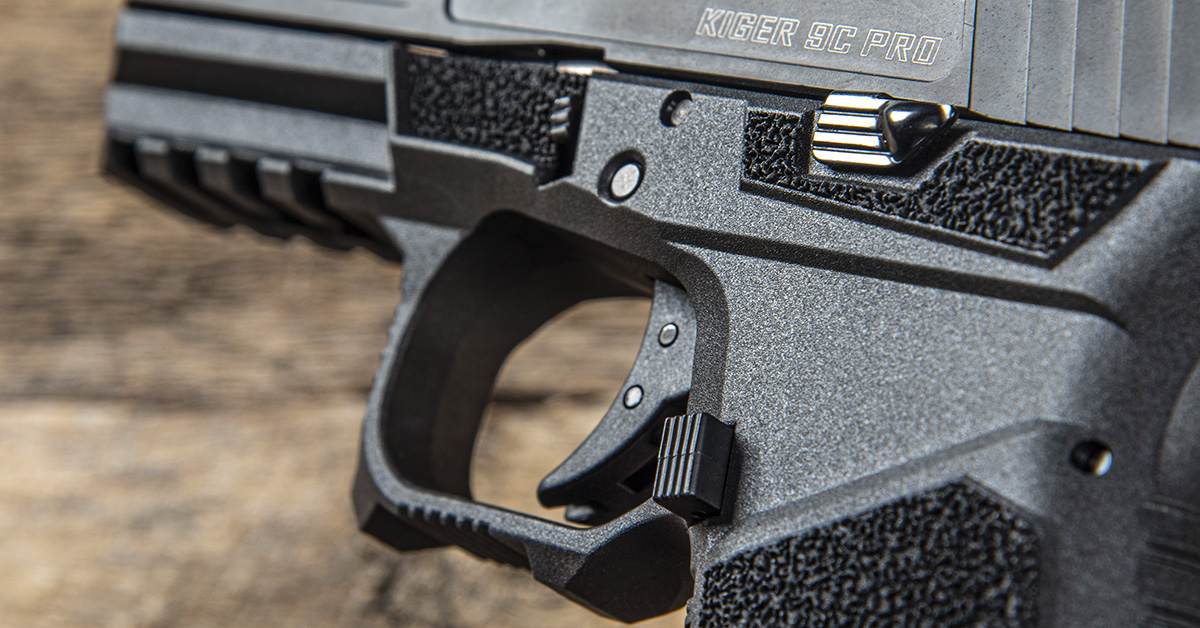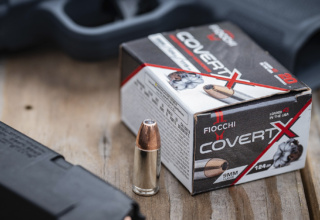Anderson Mfg. unleashes the Pro model of its new Kiger 9C 9mm compact EDC handgun
by Rob Reaser
Those of you who swim in the AR-15 pool are likely familiar with Anderson Manufacturing. The company, based in Hebron, Kentucky, is a top-tier parts manufacturer that many companies rely on for sourcing components for their rifles. Additionally, Anderson makes their own AR-15 and AR-10 models and is an excellent go-to source for DIY gun builders.
All of that to say, Anderson knows its way around the firearm and component manufacturing scene and is one of the bedrock, if not commonly known, companies in the industry.
Recently, Anderson stepped into new waters, making a move from long guns to unveil their first handgun — the Kiger 9C — last fall. Anderson followed up that effort in January with the release of the Kiger 9C Pro. The Kiger 9C Pro is built on the same platform as the first-out-of-the-gate Kiger 9C but with a few modifications to better appeal to those with modern handgun fancies, such as an optic-cut slide, specially treated and fluted barrel, factory optic-height sights, and a skeletonized slide.
Before getting into the details of the Kiger 9C Pro and our evaluation, a word on the name (since you are probably wondering).
Back in the day, Anderson Manufacturing carved for themselves a niche producing billet accessories for the Ford Mustang. That’s a background explanation for the company’s running horse logo, in case you’re curious. In keeping with that equine flow, Anderson chose Kiger as the name for its new pistol line — Kiger being a narrow strain of wild Mustangs still found in the southeastern corner of Idaho.
Get it?
Having built several ARs using Anderson components, I was rather excited to hear the company was moving into the handgun space. Unfortunately, travel, weather issues, and other editorial obligations delayed the opportunity to give the Kiger 9C a test run. That turned out to be somewhat fortuitous because once my slate was cleared for testing, Anderson already had the new Kiger 9C Pro model ready to go.
The Big Picture
As you will soon see, the Kiger series pistols follow the well-laid path of the ubiquitous polymer-frame, striker-fired handgun so common today. Looking under the hood, you’ll also find similarities to the GLOCK. That’s because the Kiger shares some component compatibility with the Gen 1-3 GLOCK pistols, as in the G19.
All Kigers are chambered for 9mm and have the same operational function as does the GLOCK. The big separator, though, is the frame design. To our sharp-eyed readers, this frame may look familiar, and it is if you have ever come across a St. Croix Tactical Solutions SCT 19 frame. SCT is a business-to-business manufacturer that produces this frame for the Anderson Kiger series, and it is also available through select retail outlets as a base for a DIY GLOCK clone build.
Anderson selected Magpul’s 15-round PMAG 15 GL 9 as the ship-with magazine. Of course, any compatible GLOCK magazine will also work in the Kiger 9C Pro. The magwell is exceedingly generous at the bottom and is beveled to make mag swaps a breeze.
The Kiger 9C Pro, like the Kiger 9C, is a compact handgun that feels and handles much like a full-size pistol. As such, it will serve everyday carry and CCW duties quite well, but the gun’s dimensions and profile push the boundaries for deep concealment.
For red dot fans, the Kiger 9C Pro is the obvious choice. Anderson chose the RMR footprint for the slide cut. To run the gun optic-free, the gun includes a slide cover plate. This is a polymer plate, not steel, that blends well with the slide’s black Diamond-Like Carbon (DLC) coating.
Rear serrations beneath the cover plate are crisp on the leading edges and generous enough to provide a sure, no-slip grip when actuating the slide. The rear sight, being optic-height and featuring a flat profile, makes one-handed cycling against a firm object quite easy.
Up front, the slide features skeletonized cuts on the sides and a large cut above the barrel. This is certainly a weight-saver and promotes quicker barrel cooling on the range. The weight reduction did not interfere with the cycle of operation during my testing, so Anderson obviously got the recoil spring rate correct for this configuration.
There are a few interesting points to mention about the barrel. Most obvious is the parallel fluting (another weight reducer) and the recessed muzzle crown. It is made of 416R stainless steel and measures 3.91 inches. As with the slide, the barrel is treated with a DLC coating for enhanced wear and corrosion resistance.
Personally, I like the flush-to-slide fit of the muzzle. It looks neat and would offer some protection to the barrel should the gun be dropped on its nose.
The trigger was a pleasant surprise. It is the familiar safety blade design with a rounded shoe face and no serrations. There are also no harsh edges to wreck your finger during long range sessions.
The big surprise, though, was the short and crisp break. I found it to be much more decisive than my factory GLOCK triggers. After the initial take-up, you hit a solid wall and then it takes only a skosh more rearward travel before the cruciform drops and disengages the firing pin lug. The reset is also blessedly short, leading to fast follow-up shots for those who can master rapid fire.
Curious as to the trigger weight, I gave it ten pulls on the Lyman scale and recorded an average of 5 lbs., 14.8 ounces.
Since lights and lasers are common add-ons for personal defense pistols, the Kiger comes with an accommodatingly long 1913 Picatinny rail. While I’m not a pistol light kind of guy, those who are will find ample acreage to install their favorite model.
Ergonomics
When I first pulled the Kiger 9C Pro out of its zippered case and wrapped my hand around the grip, I said to myself, “Woah.”
The frame, as you can see, is not shy when it comes to edges and angles. It is almost as if the designers sought to create a platform specifically devoid of smooth curves. The first-grip impression felt quite “boxy” in my hand, and I wasn’t sure where our relationship was going to go. Would this be a first and only date, or could we develop a lasting and enjoyable partnership?
First impressions aside, the frame design hit all the right notes once we began our dance on the steel range.
The slab-sided handle boasts sizeable stipling patches on both sides of the grip. They are aggressive and “sticky” without being harsh. Front and rear serrations also play their part in keeping the firing hand in position. In fact, the front serrations are robust enough that finger grooves are not missed. Wrap your hand around the Kiger and it stays put.
There are also two pairs of stipling patches along the sides of the frame rail — one pair for the firing hand thumb and one for the support hand thumb.
The trigger guard has a lot going on. For starters, it comes with a pronounced undercut that helps give you that high-and-tight grip you want. The bottom and front of the guard has serrations backed by knobs. While somewhat odd looking, these knobs work with the serrations to give your support hand index finger good traction for managing recoil and maintaining a proper grip for follow-up shots.
Operational controls on the Kiger 9C Pro are accommodating. The slide lock lever features both serrations and a small protruding ledge that offers ample traction and leverage for a no-hassle thumb-actuated slide release.
Moving forward, the slide lock lever does its job of releasing the slide for disassembly. That said, this was one area of the frame design that I think needs another run by the designer’s desk. The rearward edge of the lever is close to the frame and is recessed in the frame. This makes it slightly more difficult to pull down on the lever (right and left sides simultaneously) because your fingertips are mostly engaging the top and forward edge of the lever, not the entire lever as you would with a standard GLOCK frame. This isn’t a date killer, but it is rather uncomfortable and awkward — something that should be improved up on with future frame iterations.
Where the slide lock lever falls a bit short in convenience, the mag release lever certainly makes up for it. It is an extended version with a just-right spring tension and ample protrusion so you don’t have to fumble with or fight it during quick mag swaps.
Accuracy
Shooting unsupported at 10 yards, the Kiger 9C Pro tinged steel with delicious predictability using the factory steel sights. That raised my expectations for the accuracy portion of the evaluation.
For this, I kept the open sight configuration and set up a somewhat solid rest at ten yards, firing five-shot groups from four different manufacturer loads — two with 124-gr. bullets and two with 115 gr. projectiles. The ammo tested included Fiocchi 124-gr. FMJ Range Dynamics, Black Hills 124 gr. JHP, Blazer 115 gr. FMJ, and Barnaul 115-gr. FMJ.
With no handicap given for my deteriorating open-sight vision, the Kiger 9C Pro nevertheless proved its high accuracy potential. The best group came from the Black Hills 124-gr. JHP with its 1.423-in. five-shot performance. I have no doubt a red dot (or someone with better eyes than mine) could shrink that group size below the 1-inch threshold. Unfortunately, out of my entire red dot stash, I had none that would work with the Kiger 9C Pro’s RMR footprint, so open sight testing was the order of the day. The results were as follows:
- Black Hills 124 gr. JHP: 1.423 in.
- Fiocchi 124 gr. FMJ Range Dynamics: 1.951 in.
- Barnaul 115 gr. FMJ: 2.319 in.
- Blazer 115 gr. FMJ: 2.354 in.
Final Thoughts
From the moment I cracked open the box on the Kiger 9C Pro to the last round fired on test day, my attitude and perceptions on this gun did a 180. The pronounced angularity of the frame and the box-like feel of the grip felt quite foreign in a hand that was more accustomed to grips boasting rounded corners, palm swells, and finger grooves. Once I spent some time behind the trigger, my frowns turned to grins. The squarish grip goes a long way toward promoting good hand position and maintaining that position under repeated fire because it helps lock your hand into place under recoil, minimizing or eliminating any lateral rotation. This leads to grip consistency over the course of a mag dump.
Aesthetically, the combination of the slide and frame design simply works to my eyes. Anderson’s designers did a wonderful job of integrating functional styling cues into the slide to complement the SCT frame’s design elements.
Most importantly, the gun ran with no hiccups and proved itself to be accurate, with an accuracy potential that exceeds, at the least, this shooter’s capabilities with open sights.
Finally, there is the price. With an MSRP of $539, the Kiger 9C Pro offers a good value-to-performance ratio in a market rife with stiff competition in the compact polymer-frame striker-fired pistol category.
Anderson Mfg. Kiger 9C Pro Specifications
- Chamber: 9mm
- Pistol Size: compact
- Magazine Capacity: 15+1
- Action: striker-fired
- Barrel Material: 416R stainless steel, fluted
- Barrel Treatment: DLC
- Barrel Length: 3.91 in.
- Twist Rate: 1:10
- Slide Material: 416 stainless steel
- Slide Finish: black anodize, DLC-treated
- Grip/Frame Material: Polymer
- Overall Length: 7-in.
- Overall Width: 1-in.
- Overall Height: 5.5-in.
- Sight radius: 6.5-in.
- Trigger Pull Weight: 5 lbs., 14.8 oz. (as tested)
- Overall Weight (w/unloaded magazine): 1.1 lbs.





























